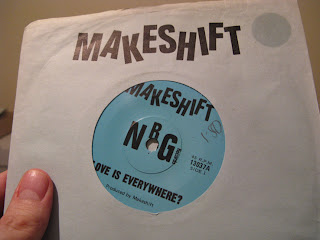In the G45 ranking the R factor (Rarity) and the S factor (Sonics) are more-or-less explanatory, but the groundbreaking aspect is the third rating, L for Legend. Like the number zero (or nihil) for ancient mathematicians, this gives us a new way of understanding the ebb-and-flow of records and why some are more desired at certain times than others. In the spirit of that, today we cover the ins-and-outs of the first Lipstick Killers 45 - Hindu Gods (Of Love) / Shakedown U.S.A.
The Lipstick Killers' story has been told at least thrice - in B-Side fanzine, then in Prehistoric Sounds, and then for the worldwide audience on the i-94 freeway. Let's recap:
- post (our Wallaby Beat forebears) the Psychosurgeons' breakup the band morphed almost immediately into Lipstick Killers, final singer Stan Armstrong being replaced by Filth's Peter Tillman, and Kim Giddy coming in on bass. David and Mark Taylor on drums and guitar made up the rest of the band;
- in 1979 the original rowdy, high-energy line-up recorded their debut single, Hindu Gods (Of Love) with Steve Harris of the Visitors on piano and Deniz Tek behind the desk;
- a year of growing popularity in Sydney based on legendary live performances followed;
- encouraged by Greg Shaw's enthusiasm the band moved to L.A. in late 1980 for a year and, while they played several shows, nought was coming of it so they broke up, eventually returning home.
 Hindu Gods (Of Love) / Shakedown U.S.A (AUS Lost In Space, PRS-2661, 1979) S3/R3/L3
Hindu Gods (Of Love) / Shakedown U.S.A (AUS Lost In Space, PRS-2661, 1979) S3/R3/L3
The first issue was an Australian EMI Custom press in a handsome picture sleeve. This one is elusive (especially without ringwear) and has maintained its legend status over the years, probably due to the sonics. Great songs, great riffs and strong vocals. Only the fact that the songs don't unhinge themselves keep it from reaching the rarefied heights of the S4s and S5s. 1000 pressed.
The first US pressing appeared on Bomp side-label Voxx. First presses come in the Blow Your Mind - Go Voxx! / Join The Voxx Rebellion company sleeve. The label font size is smaller, the Bug Music Group publishing credit is on one line, and the matrices read "Hindu" and "Shake". This variation is slightly harder to track down than the next though let's not pretend much teeth gnashing will occur before you get any of these. It appears the company sleeve can still be obtained on other 45s at the Bomp Store.
The second Voxx pressing comes with a redesigned label - larger font size, Bug Music Group credit over two lines, and more mundane catalogue number matrix etchings. The company sleeve too is redesigned, a less imperative, more self-referential "The spirit of the 60s, the sound of the 80s." This would appear to be the most common version.
Hindu Gods (Of Love) / Shakedown U.S.A (USA Voxx, 45-1003 1990?) S3/R2/L1
At some stage a third pressing took place, this time on silver labels. Somewhat surprisingly, given the perfunctory nature of much of their work, Bomp/Voxx added a lurid red picture sleeve for this actually quite seldom seen version. We vaguely recall this appearing for a few years on Bomp catalogues from about 1990. Unheralded at the time, and barely mentioned since, I can't imagine not wanting to own it.
 The rest of the Lipstick Killers discography varies from a walk in the park (Inner Mystique comp 7", Mesmerizer variations), to the mildly sweat inducing later 7"s.
The rest of the Lipstick Killers discography varies from a walk in the park (Inner Mystique comp 7", Mesmerizer variations), to the mildly sweat inducing later 7"s.Hindu Gods (Of Love) also appeared on two Bomp compilations, the Experiments In Destiny double LP (Bomp! BLP-4016) and the Where the Action Is! promo sampler LP (Bomp! BLPR-3001, 1980).
No music today, surely these songs are either known to you or easy enough to get by dragging your sorry
Update March 2013 This typed insert surfaced recently.














